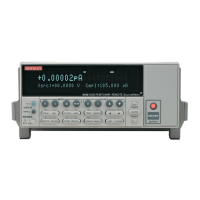Limit Testing 11-3
Data flow
All limit tests are part of the CALC2 data block. See Appendix C for an overview on how
limit testing fits into the overall data flow through the SourceMeter.
Limit 1 test (compliance)
This hardware (H/W) test checks the compliance state of the SourceMeter. It uses the pro-
grammed compliance as the test limit. At or above the programmed limit, the instrument is in
compliance. Below the limit, the instrument is not in compliance.
For example, assume you want to “pass” resistors that are below 1kΩ. To do this set the
I-Source to output 1mA at a compliance limit of 1V, and configure the test to fail on compli-
ance. If, for example, the resistor under test is 750Ω, output voltage will be 0.75V
(1mA × 750Ω = 0.75V). Since the output voltage is below the 1V limit, the test passes. If the
resistor is 1kΩ (or more), output voltage will be 1V (1mA × 1kΩ = 1V). Since the 1V limit is
reached, which places the SourceMeter in compliance, the test fails.
The Limit 1 test can be used to determine the polarity of a device, such as a diode. By using
this test with a source memory sweep, you can branch to a different setup at a specified mem-
ory location when the device is installed backwards. See the programming example at the end
of this section for details on diode testing.
Limit 2, limit 3, and limit 5-12 tests
These software (S/W) tests are used to determine if a DUT is within specified high and low
limits. Typically, the Limit 2 test is used to test for “coarse” tolerance limits, and the Limit 3
and Limit 5-12 tests are used for “fine” tolerance limits.
For example, assume you want to sort resistors into three groups: 1%, 5%, and >5% toler-
ance. To do this, configure Limit 2 test for 5% HI and LO limits, and Limit 3 test for 1% HI and
LO limits. If Limit 2 fails, the handler places the DUT in the bin labeled >5%. If Limit 2
passes, Limit 3 test is run. If Limit 3 fails, the DUT is placed in the bin labeled 5%. If Limit 3
passes, the handler places the DUT in the bin labeled 1%.
NOTE Limit 2 can be used with the percent deviation math function. See “Percent devia-
tion” in Section 7 for details.

